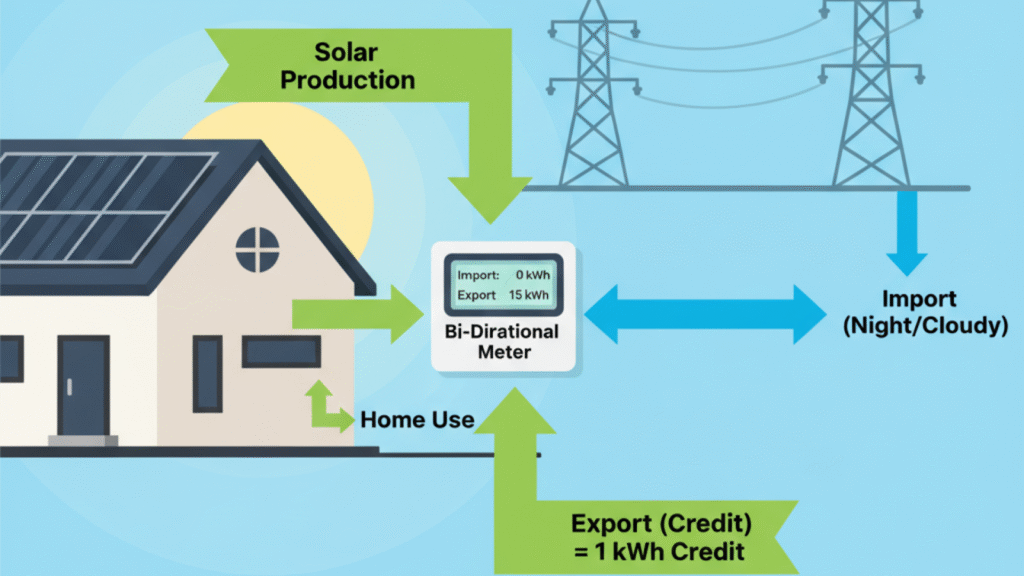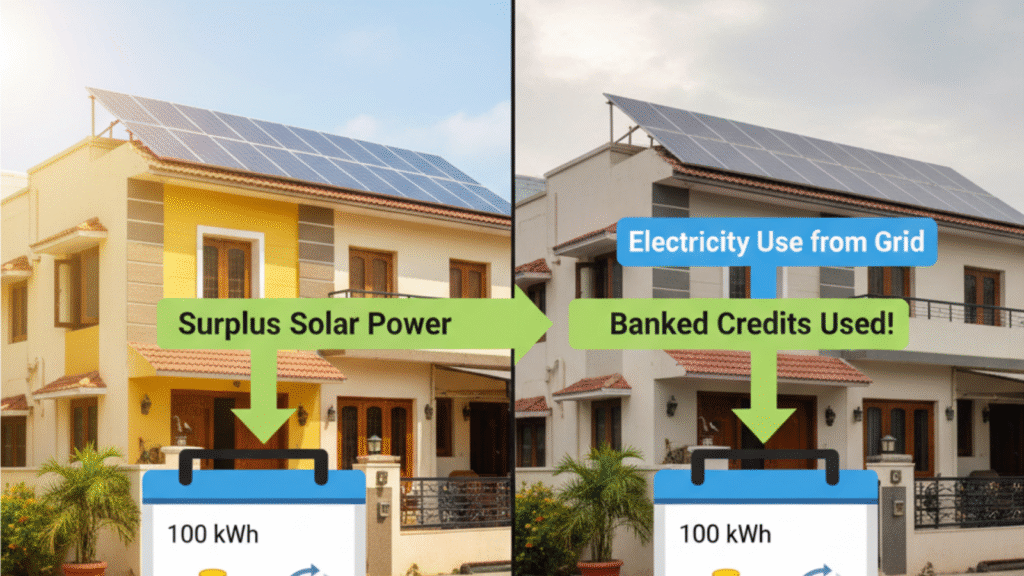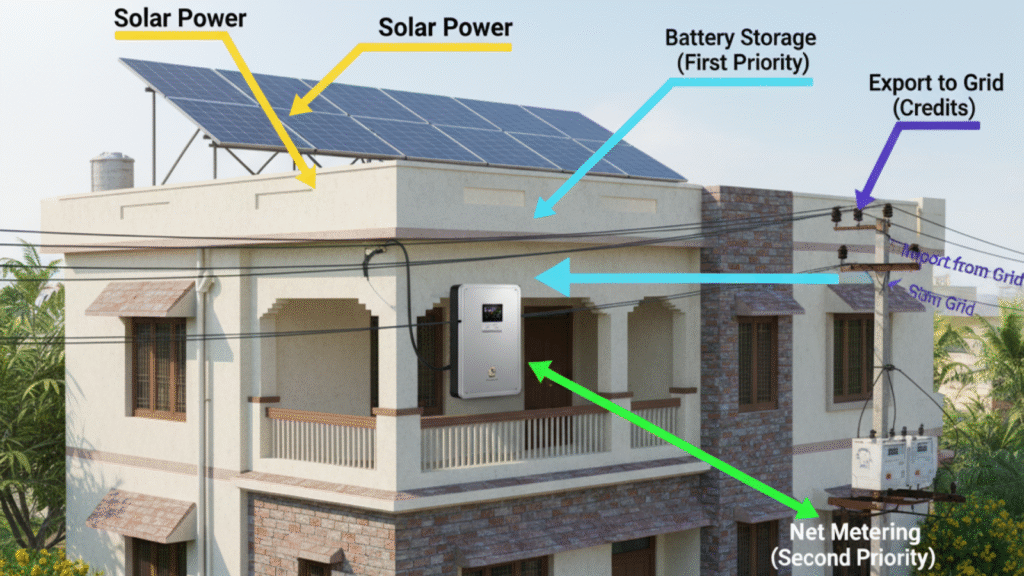
Net metering is the single most important policy that transforms a rooftop solar system from a simple power generator into a powerful financial asset. If you are considering solar panels, understanding Net Energy Metering (NEM) is absolutely crucial for calculating your return on investment and maximizing your savings.
This definitive guide will dive deep into the mechanics, economics, and policy landscape of this essential grid credit system, showing you exactly how this billing arrangement can dramatically reduce your electric bill with solar and contribute to a cleaner, more stable energy grid. Let’s start by defining this core concept.
What is Net Metering? The Definitive Technical & Economic Definition (Primary Keyword Focus)

Net metering, often referred to as Net Energy Metering (NEM), is a specialized billing mechanism that compensates owners of solar power systems (or other renewable sources like wind) for the excess electricity they generate and feed back into the utility grid. In essence, it’s a fair exchange of energy.
The Core Concept: A Two-Way Grid Connection (LSI: two-way electricity flow)
Traditionally, electricity flows one way: from the utility power plant to your home. When you install a grid-tied solar system that utilizes NEM, the flow instantly becomes two-way:
- Import (Consumption): You pull electricity from the grid at night or on cloudy days, just like a standard customer. However, you won’t pay the full price for it.
- Export (Production): During peak sun hours, your solar panels often produce more power than your home is consuming. This surplus solar power is immediately exported onto the public grid.
How the Bi-Directional Meter Works to Track Energy (LSI: bi-directional meter explained)
To enable this billing mechanism, the utility company installs a special bi-directional meter (or smart meter) to replace your old, one-directional mechanical meter.
- Crucially, this device records two values: the total amount of electricity you import (use from the grid) and the total amount of electricity you export (send back to the grid).
- Your bill is then based on the net difference (Imported kWh – Exported kWh). Consequently, you only pay for the “net” energy you consume. If you export more than you import, you build up valuable credits.
The Retail Rate Advantage (True Net Metering) (LSI: retail rate compensation)
The core financial benefit of “true” net metering is that the excess kilowatt-hours (kWh) you export are credited at the full retail electricity rate—the same price you pay to buy power. Therefore, this one-to-one exchange is the key factor that maximizes your solar savings.
The Financial Mechanics: How Net Metering Reduces Your Electric Bill (High-Value Intent Keyword)

The economic model created by NEM turns your roof into a mini power plant and fundamentally changes your financial relationship with the utility company. This is where the real savings happen.
Monthly Rollover and the Annual True-Up
The billing cycle is critical to understanding your savings potential:
- Credit Banking: If your system produces 400 kWh in a sunny July, but you only consume 300 kWh, you are left with 100 kWh of credit. Significantly, this credit is banked for you and automatically rolled over to offset power needed in the next month, such as a cold, cloudy December.
- The Annual True-Up: Most utilities mandate an annual settlement, known as the “true-up.” Generally, this is when any remaining accrued credits are settled.
- Resolution: Any leftover credits are either (a) paid out (usually at the lower wholesale rate) or (b) zeroed out (meaning they expire).
- Actionable Tip: Because of the true-up, sizing your solar system to closely match your annual energy consumption is the most effective strategy to maximize the full retail value of your credits.
Calculating Your ROI and Payback Period with Net Metering (LSI: solar panel payback period)
This billing arrangement directly accelerates your Return on Investment (ROI) by ensuring the value of your generated energy is consistently high. In fact, effective solar compensation policies often shorten the payback period by several years.
| Scenario | Without Net Metering (Net Billing) | With True Net Metering (NEM) |
| Export Value | Wholesale Rate (e.g., $0.04/kWh) | Retail Rate (e.g., $0.12/kWh) |
| Annual Savings | Moderate, primarily from self-consumption. | Maximum, from self-consumption plus full value credit for exports. |
| Payback Period | Longer (8–12 years) | Shorter (4–7 years, depending on incentives) |
Understanding Policy Shifts: Net Metering vs. Net Billing (Comparison Keywords)

As the solar industry matures and adoption increases, some utilities are transitioning away from full net metering toward other compensation structures. Consequently, it is vital to know the difference.
Net Metering vs. Net Billing: A Critical Distinction
The core distinction lies in the credit value:
- Net Metering (NEM): This is the gold standard. Credits are applied at the full retail rate for every kWh exported (1:1 value). The result is the potential for a near-zero or zero electricity bill.
- Net Billing (NB): This is less favorable for the consumer. Exports are credited at a lower, wholesale or “avoided cost” rate (e.g., 3:1 value). Although it still reduces the bill, your exports are significantly less valuable.
The Time-of-Use (TOU) Impact on Net Metering (LSI: time-of-use solar rates explained)
Many modern solar compensation programs incorporate Time-of-Use (TOU) rates. In this system, electricity prices fluctuate throughout the day.
- During TOU: You earn a high credit value for exporting power during the most expensive “peak” hours (usually late afternoon/evening). Conversely, you pull power from the grid during cheaper “off-peak” hours.
- The Strategy: This setup encourages homeowners to use, store, or export power when the grid needs it most, maximizing the financial incentive of your system.
Policy and Eligibility: Securing Your Net Metering Program (Authority and E-A-T Building)

The availability and terms of net metering are not universal; they are set by regional state and local utility regulations. Therefore, you must check your local policy.
Key Eligibility Requirements for Residential Solar
To qualify for a net metering program, most utilities require several key steps and system parameters:
- System Size Limit: The system capacity (measured in kW) must usually not exceed 10 kW for residential homes or be capped by your historic energy consumption. This ensures the program supports residential scale.
- Interconnection Agreement: A formal contract with the utility company outlining safety, maintenance, and connection standards.
- Safety & Certification: The entire system must meet all local electrical codes and safety standards to ensure the safety of utility workers who may service the lines.
Navigating the Net Metering Application Process
Successfully activating your net metering policy involves several steps:
- Initial Submission: Your installer submits a formal application and system design to the utility (DISCOM).
- Feasibility Check: The utility performs a technical review to ensure the grid can handle your system’s export capacity.
- Installation & Inspection: The solar system is installed and then inspected by local authorities.
- Meter Swap: The utility replaces your old meter with the required bi-directional meter. Finally, only after the meter is swapped, your net metering is activated.
Future-Proofing with Solar Batteries and Net Metering (Future-Proofing Keywords)

The trend in solar technology involves pairing net metering with a home battery system. As a result, this integration future-proofs your energy independence.
The Role of Battery Storage in a NEM System
A solar battery acts as an intermediary, changing when you send power to the grid:
- Storage First: Excess power is stored in the battery first. Then, you only export power to the grid (and earn a net metering credit) when the battery is completely full.
- Benefits: This setup allows you to use your own stored power at night before pulling power (and using credits) from the grid. Consequently, you rely less on utility rates and further reduce your bills.
Frequently Asked Questions (FAQ)
Q: What is net metering in simple words?
A: Net metering is a billing mechanism that allows homeowners with solar panels to get full credit for any extra power they send back to the electric grid. Think of it as using the grid as a large, free battery for your excess solar energy.
Q: Do I get paid cash for my excess solar energy?
A: Generally, no. Net metering programs primarily offer energy credits on your utility bill, not cash payments. These credits offset the power you use later. You might receive a small annual check for unused credits, but this payment is usually at a much lower wholesale rate.
Q: Can I install solar without net metering?
A: Yes, but it is highly inefficient. You can install an off-grid system or a grid-tied system without NEM. However, without net metering, any excess power you generate is usually forfeited or credited at a very low rate, severely limiting your long-term savings.
Q: How long does the net metering application process take?
A: The process varies significantly by utility and location. Typically, it takes anywhere from 4 to 12 weeks after your solar system installation is complete. It involves feasibility checks, paperwork submission, and the final installation of the bi-directional meter by the utility.
Q: Is net metering guaranteed to last forever?
A: No. Net metering policies are regulated by state commissions and local utilities and are subject to change. Therefore, acting sooner rather than later to “grandfather” your system under current, favorable net metering rules is often the most financially sound decision.
Conclusion: The Future of Energy Savings is Net Metered
Understanding what is net metering is the difference between simply owning a solar system and truly mastering your home’s energy economy. This powerful policy is not just about environmental consciousness; it is an economic driver. It makes the decision to reduce your electric bill with solar a financially sound and highly profitable investment. As energy prices continue to rise, the ability to leverage net metering for banked credits and maximum retail value will remain the single most compelling reason to transition to solar power today.

